engine DODGE VIPER SRT 2016 VX / 3.G Workshop Manual
[x] Cancel search | Manufacturer: DODGE, Model Year: 2016, Model line: VIPER SRT, Model: DODGE VIPER SRT 2016 VX / 3.GPages: 427, PDF Size: 3.02 MB
Page 262 of 427
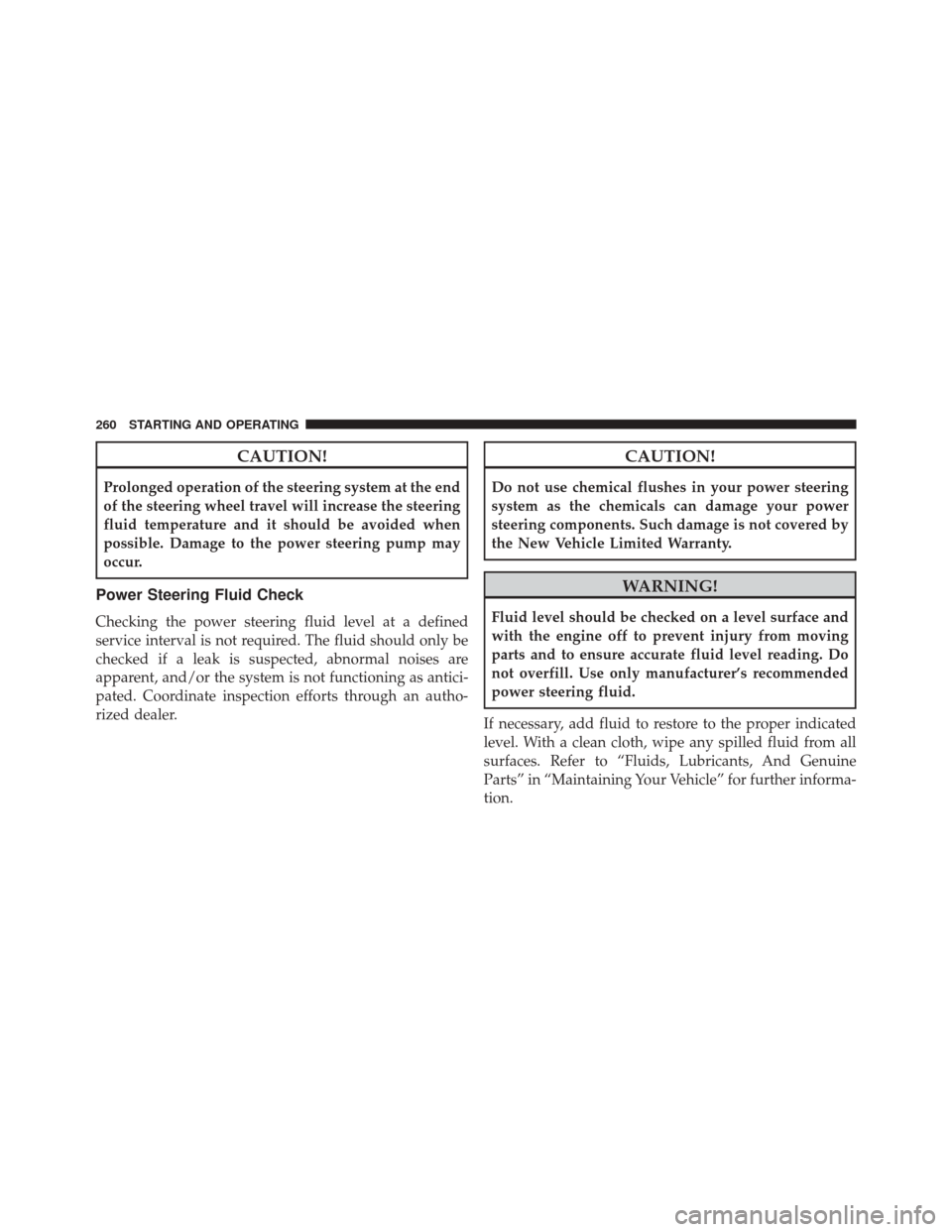
CAUTION!
Prolonged operation of the steering system at the end
of the steering wheel travel will increase the steering
fluid temperature and it should be avoided when
possible. Damage to the power steering pump may
occur.
Power Steering Fluid Check
Checking the power steering fluid level at a defined
service interval is not required. The fluid should only be
checked if a leak is suspected, abnormal noises are
apparent, and/or the system is not functioning as antici-
pated. Coordinate inspection efforts through an autho-
rized dealer.
CAUTION!
Do not use chemical flushes in your power steering
system as the chemicals can damage your power
steering components. Such damage is not covered by
the New Vehicle Limited Warranty.
WARNING!
Fluid level should be checked on a level surface and
with the engine off to prevent injury from moving
parts and to ensure accurate fluid level reading. Do
not overfill. Use only manufacturer’s recommended
power steering fluid.
If necessary, add fluid to restore to the proper indicated
level. With a clean cloth, wipe any spilled fluid from all
surfaces. Refer to “Fluids, Lubricants, And Genuine
Parts” in “Maintaining Your Vehicle” for further informa-
tion.
260 STARTING AND OPERATING
Page 265 of 427
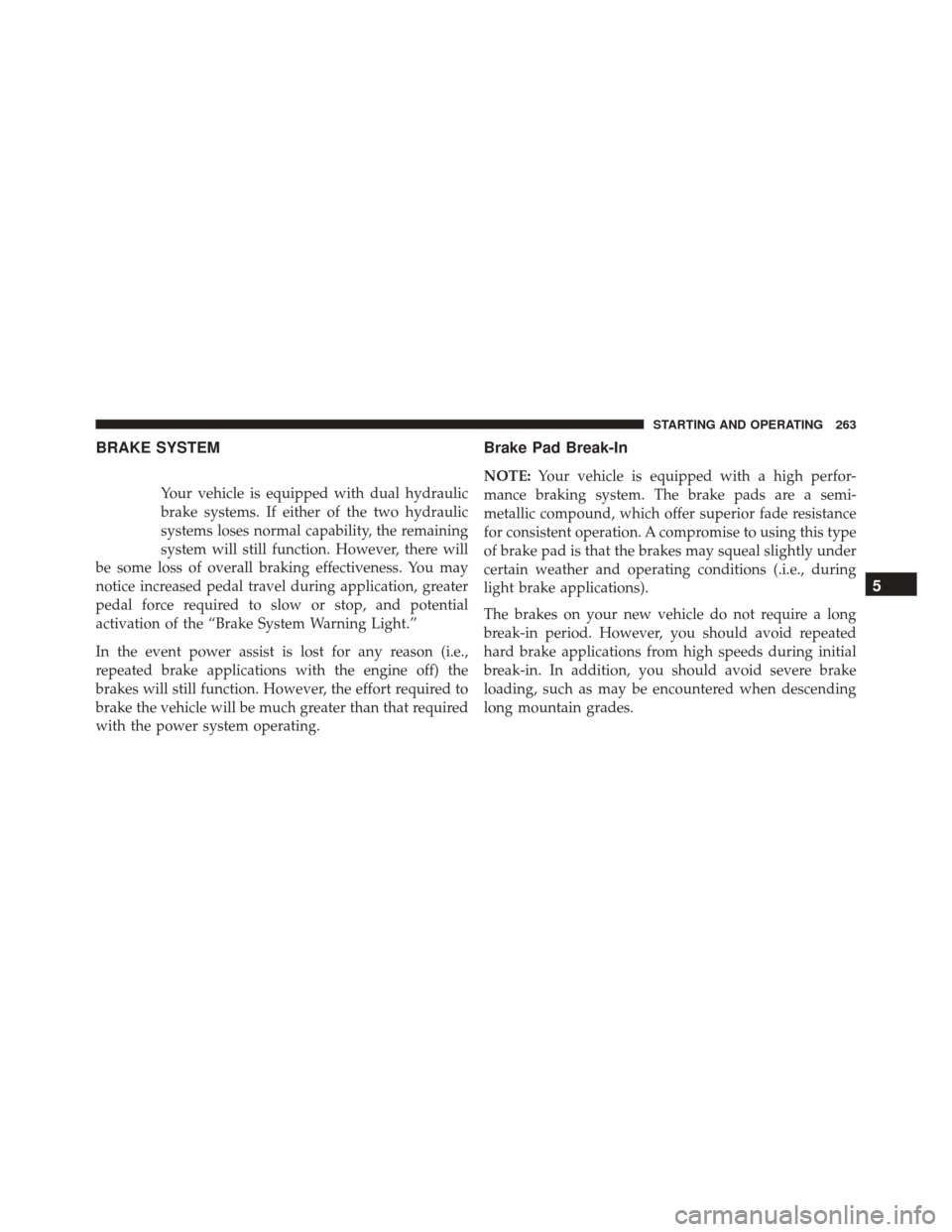
BRAKE SYSTEM
Your vehicle is equipped with dual hydraulic
brake systems. If either of the two hydraulic
systems loses normal capability, the remaining
system will still function. However, there will
be some loss of overall braking effectiveness. You may
notice increased pedal travel during application, greater
pedal force required to slow or stop, and potential
activation of the “Brake System Warning Light.”
In the event power assist is lost for any reason (i.e.,
repeated brake applications with the engine off) the
brakes will still function. However, the effort required to
brake the vehicle will be much greater than that required
with the power system operating.
Brake Pad Break-In
NOTE: Your vehicle is equipped with a high perfor-
mance braking system. The brake pads are a semi-
metallic compound, which offer superior fade resistance
for consistent operation. A compromise to using this type
of brake pad is that the brakes may squeal slightly under
certain weather and operating conditions (.i.e., during
light brake applications).
The brakes on your new vehicle do not require a long
break-in period. However, you should avoid repeated
hard brake applications from high speeds during initial
break-in. In addition, you should avoid severe brake
loading, such as may be encountered when descending
long mountain grades.
5
STARTING AND OPERATING 263
Page 269 of 427
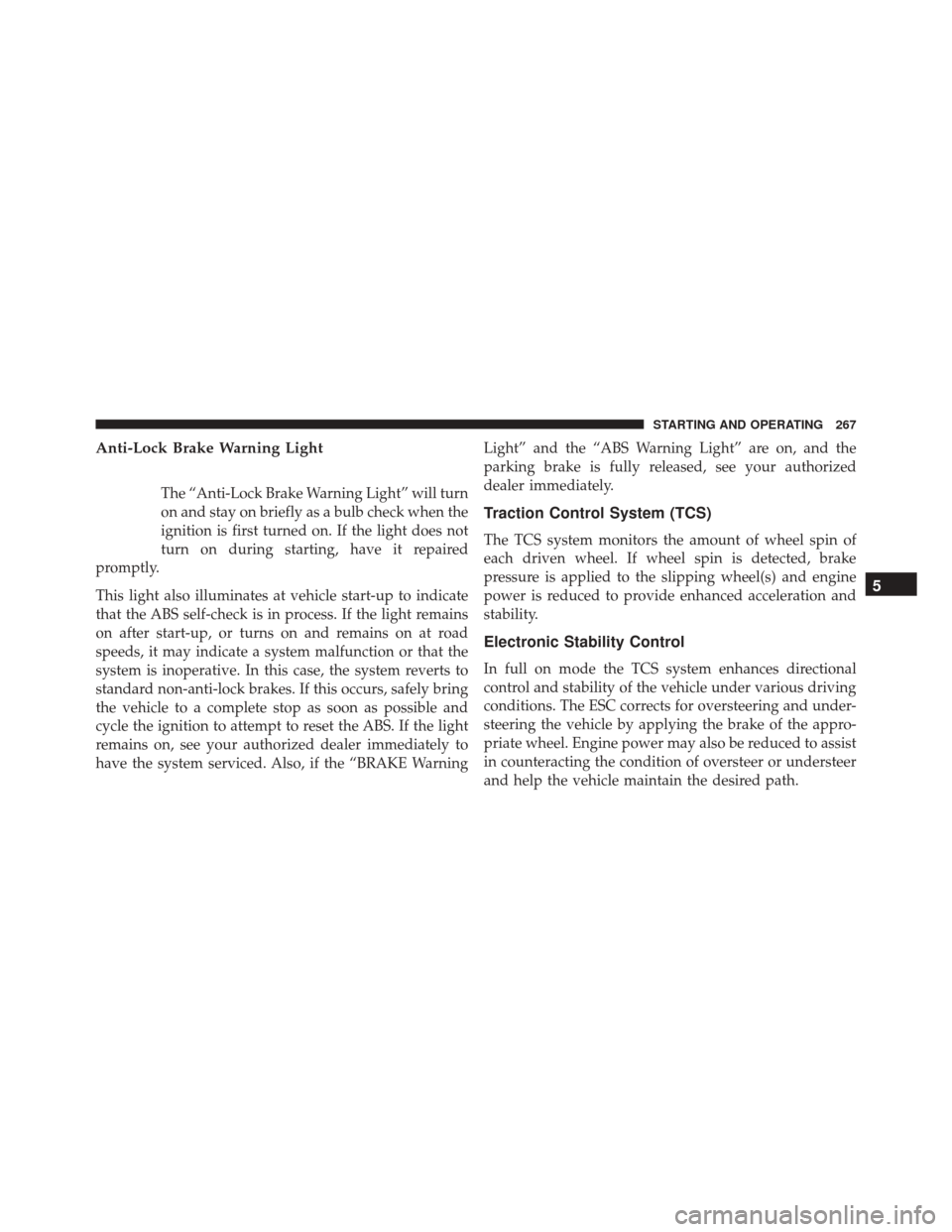
Anti-Lock Brake Warning Light
The “Anti-Lock Brake Warning Light” will turn
on and stay on briefly as a bulb check when the
ignition is first turned on. If the light does not
turn on during starting, have it repaired
promptly.
This light also illuminates at vehicle start-up to indicate
that the ABS self-check is in process. If the light remains
on after start-up, or turns on and remains on at road
speeds, it may indicate a system malfunction or that the
system is inoperative. In this case, the system reverts to
standard non-anti-lock brakes. If this occurs, safely bring
the vehicle to a complete stop as soon as possible and
cycle the ignition to attempt to reset the ABS. If the light
remains on, see your authorized dealer immediately to
have the system serviced. Also, if the “BRAKE Warning Light” and the “ABS Warning Light” are on, and the
parking brake is fully released, see your authorized
dealer immediately.
Traction Control System (TCS)
The TCS system monitors the amount of wheel spin of
each driven wheel. If wheel spin is detected, brake
pressure is applied to the slipping wheel(s) and engine
power is reduced to provide enhanced acceleration and
stability.
Electronic Stability Control
In full on mode the TCS system enhances directional
control and stability of the vehicle under various driving
conditions. The ESC corrects for oversteering and under-
steering the vehicle by applying the brake of the appro-
priate wheel. Engine power may also be reduced to assist
in counteracting the condition of oversteer or understeer
and help the vehicle maintain the desired path.
5
STARTING AND OPERATING 267
Page 271 of 427
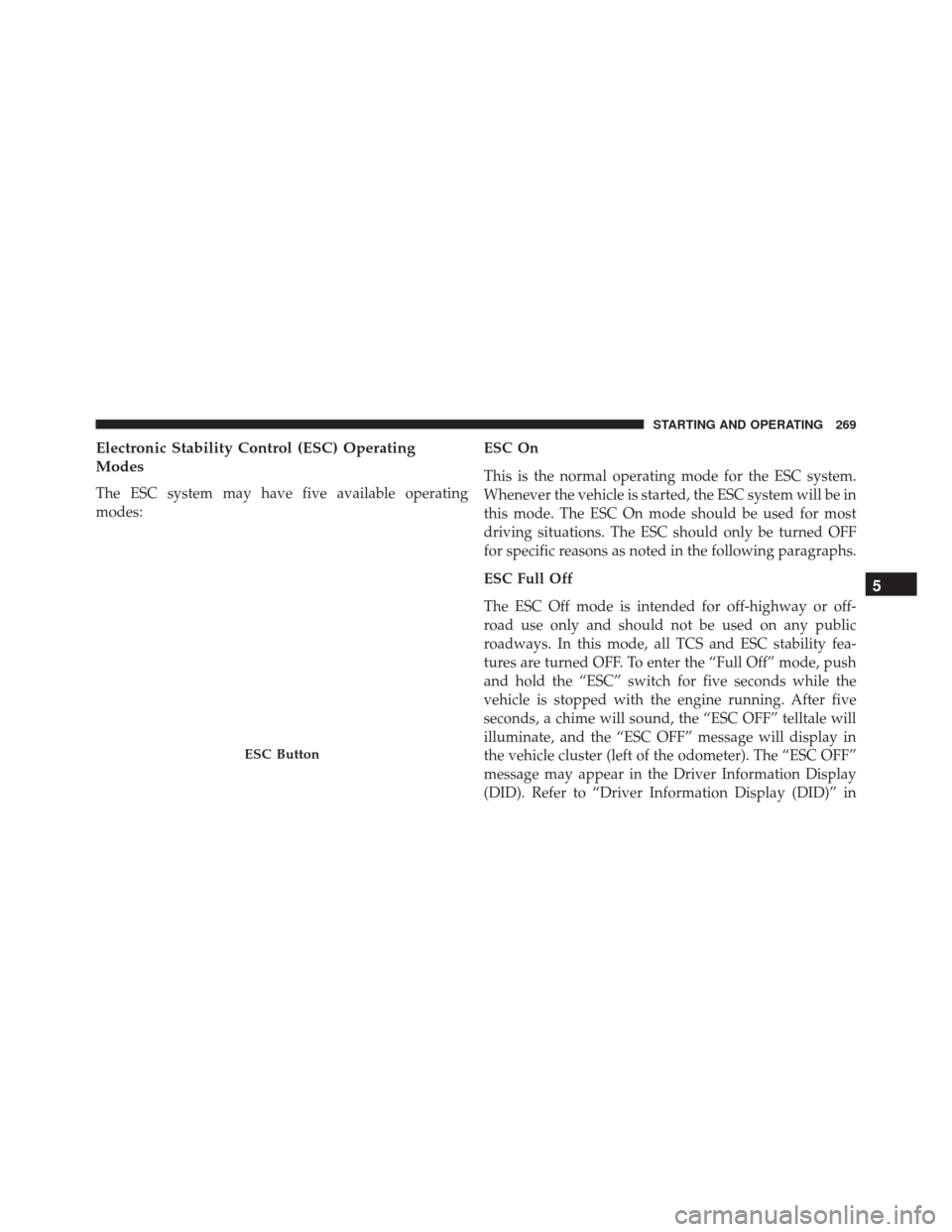
Electronic Stability Control (ESC) Operating
Modes
The ESC system may have five available operating
modes:ESC On
This is the normal operating mode for the ESC system.
Whenever the vehicle is started, the ESC system will be in
this mode. The ESC On mode should be used for most
driving situations. The ESC should only be turned OFF
for specific reasons as noted in the following paragraphs.
ESC Full Off
The ESC Off mode is intended for off-highway or off-
road use only and should not be used on any public
roadways. In this mode, all TCS and ESC stability fea-
tures are turned OFF. To enter the “Full Off” mode, push
and hold the “ESC” switch for five seconds while the
vehicle is stopped with the engine running. After five
seconds, a chime will sound, the “ESC OFF” telltale will
illuminate, and the “ESC OFF” message will display in
the vehicle cluster (left of the odometer). The “ESC OFF”
message may appear in the Driver Information Display
(DID). Refer to “Driver Information Display (DID)” in
ESC Button
5
STARTING AND OPERATING 269
Page 272 of 427

“Understanding Your Instrument Panel” for further in-
formation. To turn ESC ON again, momentarily push the
“ESC” switch.
WARNING!
With the ESC switched OFF, the enhanced vehicle
stability offered by ESC is unavailable. In an emer-
gency evasive maneuver, the ESC system will not
engage to assist in maintaining stability. The “Full
Off” ESC mode is intended for off-highway or off-
road only.
Sport Mode — If Equipped
Sport mode has reduced traction control and reduced
stability control. To enter the “Sport Mode” mode, push
the “ESC” switch once (located on the steering wheel).
The “ESC OFF” telltale will illuminate, and the “ESC
SPORT” message will display in the vehicle cluster (left of the odometer). Refer to “Driver Information Display
(DID)” in “Understanding Your Instrument Panel” for
further information.
WARNING!
When in Sport Mode, the TCS functionality of ESC,
(except for the limited slip feature described in the
TCS section), has been disabled, the “ESC Sport
Light” will illuminate, and the “ESC SPORT” mes-
sage will display in the vehicle cluster. When in
Sport Mode, the engine power reduction feature of
TCS is disabled, and the enhanced vehicle stability
offered by the ESC system is reduced.
Track Mode — If Equipped
Track Mode has no traction control and has reduced
stability control. To enter the “Track Mode” mode, push
the “ESC” switch twice. The “ESC OFF” telltale will
270 STARTING AND OPERATING
Page 273 of 427
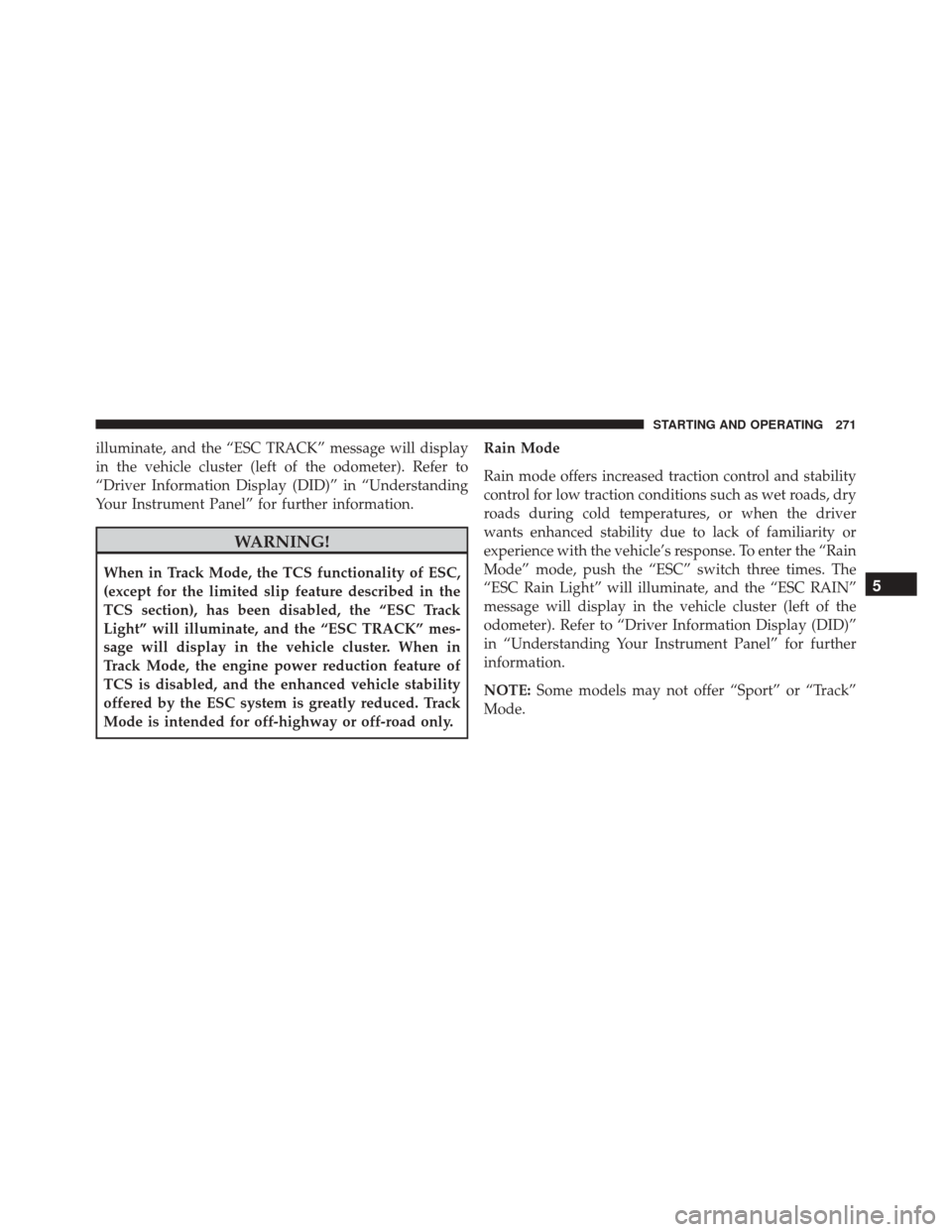
illuminate, and the “ESC TRACK” message will display
in the vehicle cluster (left of the odometer). Refer to
“Driver Information Display (DID)” in “Understanding
Your Instrument Panel” for further information.
WARNING!
When in Track Mode, the TCS functionality of ESC,
(except for the limited slip feature described in the
TCS section), has been disabled, the “ESC Track
Light” will illuminate, and the “ESC TRACK” mes-
sage will display in the vehicle cluster. When in
Track Mode, the engine power reduction feature of
TCS is disabled, and the enhanced vehicle stability
offered by the ESC system is greatly reduced. Track
Mode is intended for off-highway or off-road only.Rain Mode
Rain mode offers increased traction control and stability
control for low traction conditions such as wet roads, dry
roads during cold temperatures, or when the driver
wants enhanced stability due to lack of familiarity or
experience with the vehicle’s response. To enter the “Rain
Mode” mode, push the “ESC” switch three times. The
“ESC Rain Light” will illuminate, and the “ESC RAIN”
message will display in the vehicle cluster (left of the
odometer). Refer to “Driver Information Display (DID)”
in “Understanding Your Instrument Panel” for further
information.
NOTE:
Some models may not offer “Sport” or “Track”
Mode.5
STARTING AND OPERATING 271
Page 304 of 427

NOTE:Changes or modifications not expressly approved
by the party responsible for compliance could void the
user ’s authority to operate the equipment.
Gulf Coast Countries (GCC)
TPMS
TRA
REGISTERED No: ER0097573/12
DEALER No: DA0047074/10
CORAX3
TRA
REGISTERED No: ER37066/15
DEALER No: DA0047074/10FUEL REQUIREMENTS
8.4L Engine
The 8.4L engine is designed to meet all
emissions regulations, provide optimal
fuel economy and performance when us-
ing high-quality unleaded “Premium”
gasoline having a posted octane number of
91 as specified by the (R+M)/2 method. The use of 91 or
higher octane “Premium” gasoline is required for in this
engine.
While operating on gasoline with the required octane
number, hearing a light knocking sound from the engine
is not a cause for concern. However, if the engine is heard
making a heavy knocking sound, see your dealer imme-
diately. Use of gasoline with a lower than recommended
octane number can cause engine failure and may void or
not be covered by the New Vehicle Limited Warranty.
302 STARTING AND OPERATING
Page 305 of 427
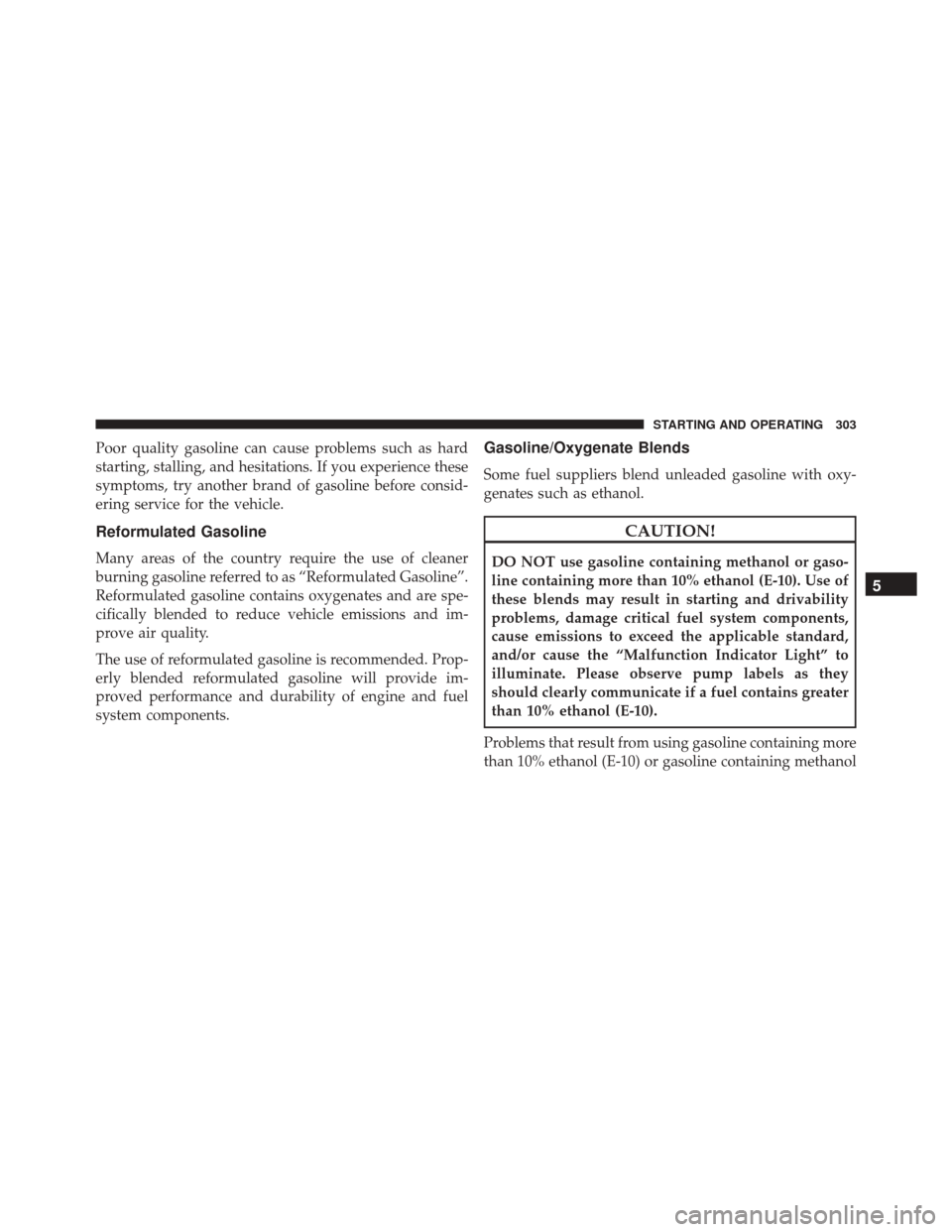
Poor quality gasoline can cause problems such as hard
starting, stalling, and hesitations. If you experience these
symptoms, try another brand of gasoline before consid-
ering service for the vehicle.
Reformulated Gasoline
Many areas of the country require the use of cleaner
burning gasoline referred to as “Reformulated Gasoline”.
Reformulated gasoline contains oxygenates and are spe-
cifically blended to reduce vehicle emissions and im-
prove air quality.
The use of reformulated gasoline is recommended. Prop-
erly blended reformulated gasoline will provide im-
proved performance and durability of engine and fuel
system components.
Gasoline/Oxygenate Blends
Some fuel suppliers blend unleaded gasoline with oxy-
genates such as ethanol.
CAUTION!
DO NOT use gasoline containing methanol or gaso-
line containing more than 10% ethanol (E-10). Use of
these blends may result in starting and drivability
problems, damage critical fuel system components,
cause emissions to exceed the applicable standard,
and/or cause the “Malfunction Indicator Light” to
illuminate. Please observe pump labels as they
should clearly communicate if a fuel contains greater
than 10% ethanol (E-10).
Problems that result from using gasoline containing more
than 10% ethanol (E-10) or gasoline containing methanol
5
STARTING AND OPERATING 303
Page 306 of 427

are not the responsibility of the manufacturer and may
void or not be covered under New Vehicle Limited
Warranty.
E-85 Usage In Non-Flex Fuel Vehicles
Non-Flex Fuel Vehicles (FFV) are compatible with gaso-
line containing up to 10% ethanol (E-10). Gasoline with
higher ethanol content may void the New Vehicle Lim-
ited Warranty.
If a Non-FFV vehicle is inadvertently fueled with E-85
fuel, the engine will have some or all of these symptoms:
•Operate in a lean mode.
• OBD II “Malfunction Indicator Light” on.
• Poor engine performance.
• Poor cold start and cold drivability.
• Increased risk for fuel system component corrosion.
MMT In Gasoline
Methylcyclopentadienyl Manganese Tricarbonyl (MMT)
is a manganese-containing metallic additive that is
blended into some gasoline to increase octane. Gasoline
blended with MMT provides no performance advantage
beyond gasoline of the same octane number without
MMT. Gasoline blended with MMT reduces spark plug
life and reduces emissions system performance in some
vehicles. The manufacturer recommends that gasoline
without MMT be used in your vehicle. The MMT content
of gasoline may not be indicated on the gasoline pump,
therefore, you should ask your gasoline retailer whether
the gasoline contains MMT. MMT is prohibited in Federal
and California reformulated gasoline.
Materials Added To Fuel
Besides using unleaded gasoline with the proper octane
rating, gasolines that contain detergents, corrosion and
stability additives are recommended. Using gasolines
304 STARTING AND OPERATING
Page 307 of 427
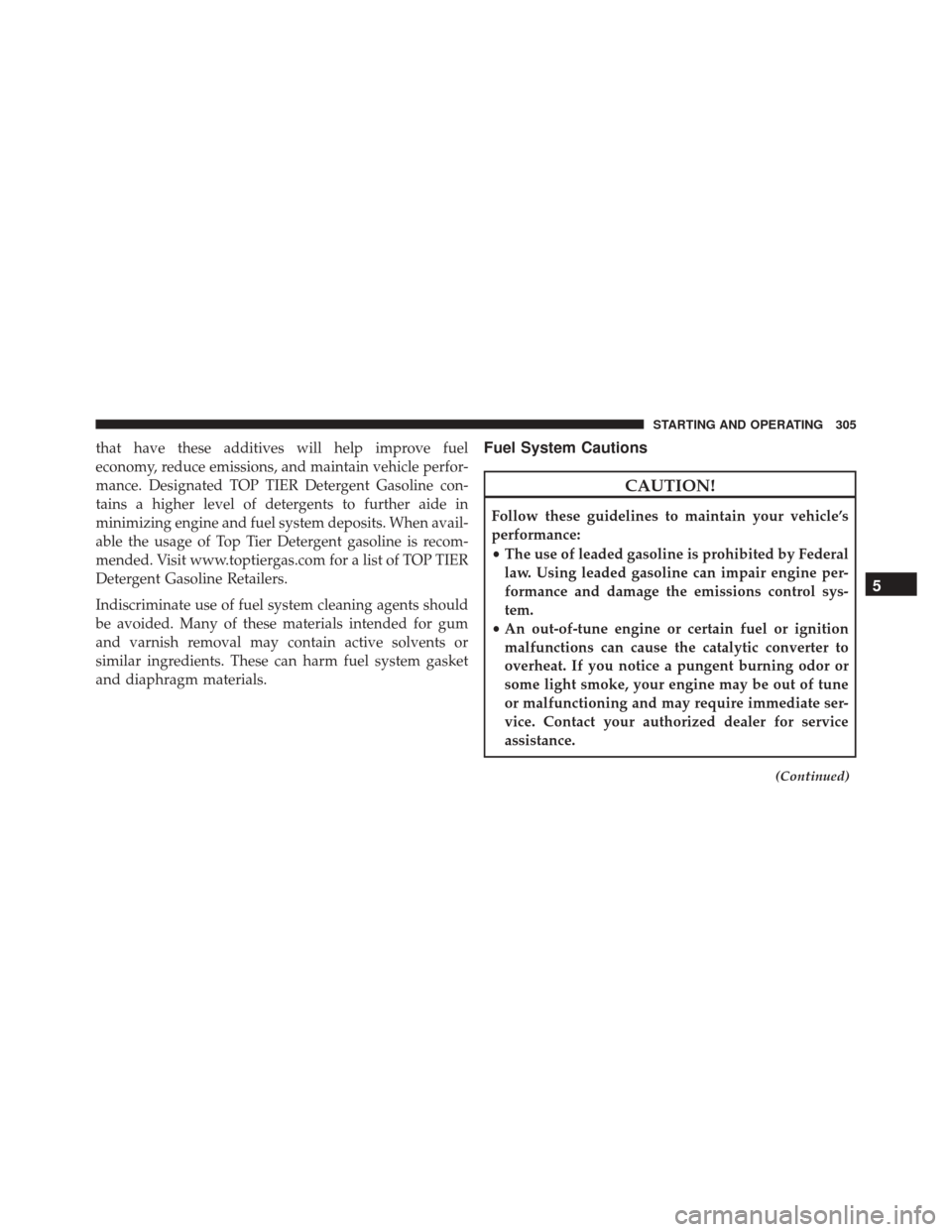
that have these additives will help improve fuel
economy, reduce emissions, and maintain vehicle perfor-
mance. Designated TOP TIER Detergent Gasoline con-
tains a higher level of detergents to further aide in
minimizing engine and fuel system deposits. When avail-
able the usage of Top Tier Detergent gasoline is recom-
mended. Visit www.toptiergas.com for a list of TOP TIER
Detergent Gasoline Retailers.
Indiscriminate use of fuel system cleaning agents should
be avoided. Many of these materials intended for gum
and varnish removal may contain active solvents or
similar ingredients. These can harm fuel system gasket
and diaphragm materials.Fuel System Cautions
CAUTION!
Follow these guidelines to maintain your vehicle’s
performance:
•The use of leaded gasoline is prohibited by Federal
law. Using leaded gasoline can impair engine per-
formance and damage the emissions control sys-
tem.
• An out-of-tune engine or certain fuel or ignition
malfunctions can cause the catalytic converter to
overheat. If you notice a pungent burning odor or
some light smoke, your engine may be out of tune
or malfunctioning and may require immediate ser-
vice. Contact your authorized dealer for service
assistance.
(Continued)
5
STARTING AND OPERATING 305